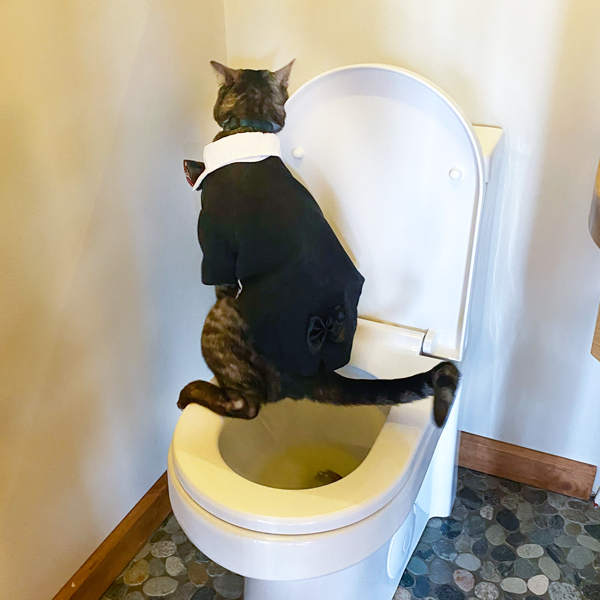
Toilet Training Your Cat
Share
Toilet training your cat takes dedication and patience, but it can be done. This is the method I used, most of which I found online or was told to me by a friend, some I learned the hard way. The most important thing to remember is to go very slow, make every change as small as possible, and sometimes you will have to take a step backwards. Let your cat dictate the pace.
Initially I tried to make my own system, but then I found CitiKitty. Their trays were exactly what I wanted. If you order directly from their website you can buy additional insert trays. I highly recommend this, it will allow you to have the next tray already cut for a quick swap out without cleaning the tray first, and a quick backtrack if needed. What I didn’t do initially but would do next time, as soon as you receive the system, take the main tray that fits over the toilet bowl and cut the center tray out to the largest perforation. This allows you to just use the insert trays and not have to muck with cleaning out the large tray. It is also possible to just buy their insert trays and cut out a piece of cardboard that can sit on the toilet and hold the insert (this will not be quite as sturdy as the large tray that comes with their kit). If you have a compact marine head on a boat, I was able to use just the insert directly in the toilet, it was a snug fit.
Litter: they do make some flushable litters, most of these are an organic substance such as wheat or corn. Whatever litter you decide to use, make sure the cat will use it first! My girl would have nothing to do with a natural litter and I had to find a clay based litter to use. I even added a sprinkling of catnip to the litter to help attract them.
Before getting started: 1. Decide which toilet you are going to train your cat on, if you have options. You can switch toilets but it usually requires a few steps backwards and slows down the process.
2. Securely tape to the tank (or remove) the lid for the toilet seat. I learned this one the hard way when my two cats somehow managed to knock the lid down, probably while one of them was on the toilet as she took weeks to get back on it.
At the same time I started toilet training I also started clicker training my cat. Later in the toilet training I found this to a useful tool to help in the last step of completely removing the training tray. There are many great instructions online that can show you how to clicker train your cat. Teaching them to jump up on a stool or chair on command is useful, but sit, shake and lay down are fun 😉
You are now ready to begin. None of these steps really have a set timeframe, your cat will have to dictate how quick or slow you can progress. If you are training more than one cat your training time will at least double.
Step 1: Move the litter box beside the toilet. Once the cat is comfortable with the new location, it’s time to start raising the litter box. The goal is to slowly raise the litter box to the height of the toilet, so that they are jumping on the toilet to get to the litter box. During this time reduce the litter in the box so they are used to not having really deep litter to scratch in. This is a tricky step as you will need to make sure that the litter box is VERY secure on whatever you are using to raise it up. I thought mine was taped down and secure until I discovered an overturned litter box one day and a cat that didn’t want to use it again 🙁 I also found once I put the training tray on the toilet my cat was happy to just jump up and use it, so I skipped over the rest of the raising the litter box. Let you cat dictate how slow or quick this step will be.
Step 2: Place the training tray on the toilet with no holes in it, and put a fair amount of litter in it. At this point you want it to be similar to their litter box. As soon as the cat is comfortable jumping up and using it you can start to reduce the litter. You will need to keep enough litter in the tray to keep the cat comfortable and to soak up pee, but the less litter in the tray will also mean less litter going in the toilet. You should take a week or more on this step. Let your cat dictate how long they need to get comfortable, you want them very comfortable on the toilet before you start cutting holes.
Step 3: Time to start your first hole. The CitiKitty system has perforations about every inch on their tray for cutting out, the perforations are a guide and will still need cut. I generally found that 1” was way too much to cut out at a time for my cat, and instead cut about 1/4” sections at a time, sometimes even less. The idea is to get them used to the new size hole each time, and enlarge it so slowly that it never seems like much of a change. Monitor them carefully right after each change, if you went too quickly and the cat is unhappy and does not want to use it, you will need to go back to the last tray they happily used. This is also why it’s good to have several trays.
The first cut will be the center hole. This can be cut out on the perforations. Give the cat a week, or more if needed with this first change. The slower the better. If they decide they don’t like a change and go potty elsewhere it is harder to correct the behavior than it is to just go very slow.
Step 4: Start the process of gradually making the hole larger. Make sure the cat has plenty of time to adjust to the change before increasing it further. If they are ever unhappy with a change, just put the last tray back in and give them more time. Once they are hitting in the hole, the litter can get reduced to nearly a sprinkle.
Step 5: Depending on your cat, I found completely getting rid of the tray to be tough. I was down to less than 1”, but if it wasn’t there she was unhappy. I found that telling her to get up on the toilet and rewarding with the clicker and a treat, I was able to remove the tray within a couple of days.
